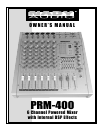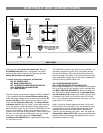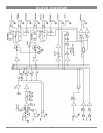
CONTROLS AND CONNECTIONS
10
by the Channel faders, and the Right speaker output is the
signal controlled by the Channel AUX controls (7).
Therefore the Main speakers, for example, can be controlled
by the individual Channel faders (11) and the Left Master
fader (27A), and the Monitor speakers by the Channel AUX
controls (7) and the Right Master fader (27B). In this
mode, any Master EQ (22) or Effects (8,28,32) selected on
the EFECTS bus will be output on both the Left and Right
Speaker outputs. The Left and Right Master inserts (14,15)
operate individually on either channel as in normal stereo
operation.
c. Digital Echo Effects Function and Operation
(20) EFFECTS DISPLAY
(21) ECHO EFFECT SELECT BUTTONS
(32) EFFECT SEND
(33) EFFECT (ECHO) REPEAT
(34) EFFECT PAN
(35) EFFECT PFL
(28) EFFECT FADER
The built-in DSP (Digital Sound Processor) offers 16 different
preset level and echo intervals selectable by the Echo Effect
Select UP/DOWN buttons (21). Press either button to scroll
in either direction through the 16 presets. The numeric
Effects Display (20) will indicate which of the 16 effect pre-
sets has been selected. The DSP processes the signal on the
EFFECTS bus, which is the sum of the 6 individual channel
inputs controlled by the EFF control (8). The EFFECT SEND
control (32) adjusts the level of the signal on the EFFECTS
bus fed to the DSP. The EFFECT (ECHO) REPEAT control
(33) adjusts the number of repeats of the echo effect selected
with the UP/DOWN buttons (21) and the EFFECTS fader
(28) controls the signal level sent to the Master Mix busses.
The output of the DSP is sent proportionately to the Left and
Right Master Mix busses as adjusted by the EFFECT PAN
control (34). The EFFECT PFL button (35) can be
depressed to monitor the pre-EFFECTS fader (28) DSP out-
put through the Monitor Headphones jack (37).
d. Monitor Function and Operation
(37) HEADPHONES OUTPUT
(36) PHONES LEVEL CONTROL
(18) MONO MONITOR OUTPUT
The PRM-400 allows you to monitor the Stereo Master Mix or
any signals selected by the channel PFL (10) or EFFECTS
PFL (35). The signal level is adjusted with the Phones Level
control (36) and routed to the Headphones (37) output. The
Phones Output (37) will feed headphones and is a 1/4” TRS
jack, wired: tip = left signal, ring = right signal, sleeve =
ground. (Note: Use only headphones with an impedance
>50Ω or you may experience some distortion.)
If desired, this output can also be connected instead to an
amplifier and speakers for control room or stage monitoring.
The MONO Monitor Out Jack (18) is another useful output
which can be used to feed a signal to a monitor amp or other
mixer. The signal on this output is taken from the AUX bus
(29)
(30)
(31)
(32)
(33)
(34)
(35)
(36)
(37)

















